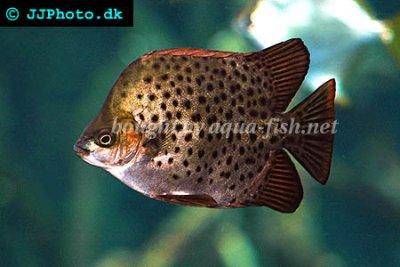Spotted scat - Scatophagus argus
Scientific name: Scatophagus argus
Common name: Spotted scat
Family: Scatophagidae
Usual size in fish tanks: 25 - 30 cm (9.84 - 11.81 inch)
014
Recommended pH range: 7.5 - 8.5
Recommended water hardness: 12 - 18°N (214.29 - 321.43ppm)
0°C 32°F30°C 86°F
Recommended temperature range: 22 - 28 °C (71.6 - 82.4°F)
The way how these fish reproduce: Spawning
Where the species comes from: South Asia
Temperament to its own species: aggressive/territorial
Temperament toward other fish species: aggressive/territorial
Usual place in the tank: Middle levels
Origin
The Spotted Scat is commonly found in estuaries and streams where fresh and saltwater mix, and they can also live in fully marine environments. They are native to coastal waters ranging from Japan to Australia.
Lifespan
With proper care, Spotted Scats can enjoy a long lifespan of 10 to 20 years. Ensuring their needs are met helps them live a full and healthy life.
Short Description
Spotted Scats can be caught in both fresh and brackish waters, but once they reach fish stores, it's hard to know their origin. Freshwater specimens are more likely to adapt well to home aquariums, while those from brackish or saltwater are more sensitive to water conditions.
They come in two main color variations: Green Scat and Red Scat (sometimes called Ruby Scat). Young fish have striking dark spots on their bodies and fins, but these spots may fade as they mature.
Spotted Scats are not ideal for beginners. They start in freshwater but need to be gradually acclimated to brackish water as they grow. This process requires patience and careful management. Additionally, their small spines contain a toxin that can cause pain to humans, so handle them with care.
Due to their size, they need a large aquarium and a strong filtration system. They produce a lot of waste, so regular water changes are essential to maintain water quality.
Spotted Scats may view smaller tank mates as potential food, so they should be kept with fish of similar size. They are generally not aggressive towards other fish.
Food
Spotted Scats are true omnivores and will eat both meat and vegetable matter. They can even consume the fecal matter of other fish. Their diet should include more vegetables than meat. Offer brine shrimp, chopped earthworms, or chopped prawns for meaty foods, and high-quality flake food, nori, or chopped spinach for vegetables.
Sexing
There is currently no known method to determine the sex of Spotted Scats without causing harm to the fish.
Breeding
Little is known about Spotted Scat breeding habits. It is believed that they breed in saltwater, with the young migrating to brackish or freshwater environments.
Pictures
Images provided by aqua-fish.net, sourced from jjphoto.dk.







